
Venkateswara, Venkatachalapati, Balaji, or Srinivasa, is a form of the Hindu deity Vishnu and is the presiding deity of the Venkateshwara Temple, located in Tirupati, Andhra Pradesh, India. Venkateshwara is also known by various other names. The deity is worshiped by North Indians by the name 'Balaji'.

Tirumala is a spiritual place in Tirupati district of the Indian state of Andhra Pradesh. It is one of the neighbourhoods of the Tirupati city. The town is a part of Tirupati Urban Development Authority and located in Tirupati (urban) mandal of Tirupati revenue division. It is a hill town where Tirumala Venkateswara Temple is located, a popular shrine of Vishnu. The town is strictly vegetarian.
Kuppam is a City in Chittoor district of the Indian state of Andhra Pradesh. It is located 115.8 kilometers south-east of Bangalore, the capital city of Karnataka, and 243 kilometers west of Chennai, the capital of Tamil Nadu. It is the headquarters of Kuppam mandal in the Kuppam Revenue Division. The name "Kuppam" means a meeting place or confluence.

Tirupati is a city in the Indian state of Andhra Pradesh. It is the administrative headquarters of the Tirupati district. The city is home to the important Hindu shrine of Tirumala Venkateshwara Temple and other historic temples. It is located at a distance of 150 km from Chennai, 250 km from Bangalore, 406 km from Amaravati. It is one of the eight Svayam vyakta kshetras dedicated to Vishnu. Tirupati is a municipal corporation and the headquarters of Tirupati (urban) mandal, Tirupati (rural) mandal, and the Tirupati revenue division.
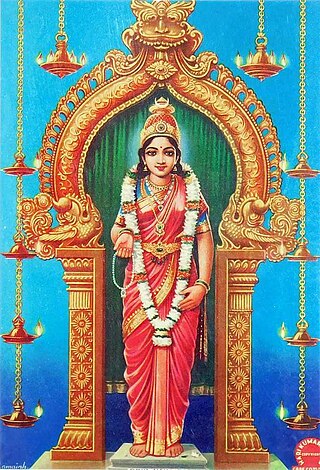
Devi Kanya Kumari is a manifestation of the Hindu goddess Mahadevi in the form of an adolescent girl. She is variously described by various traditions of Hinduism to either be a form of Parvati or Lakshmi. She is also worshipped as an incarnation of the goddess Bhadrakali by Shaktas, and is known by several names such as Shrī Bāla Bhadra, Shrī Bāla, Kanya Devi, and Devi Kumari.
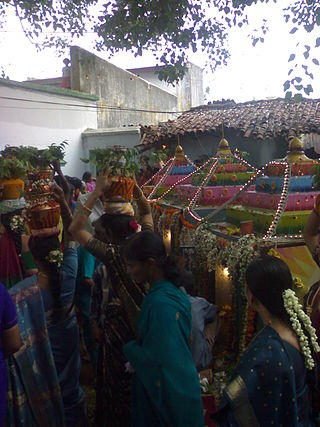
Bonalu( Telugu: బోనాలు) is a traditional Hindu festival centered on the Goddess Mahakali from Telangana. This festival is celebrated annually in the twin cities of Hyderabad and Secunderabad, as well as in other parts of the state. It is celebrated in the month of Ashada Masam, which is around July and/or August. Special "poojas" are performed for Yellamma on the first and last day of the festival. The festival is also considered a thanksgiving to the Goddess for fulfillment of vows.

The Sri Venkateswara Swami Temple is a Hindu temple situated in the hills of Tirumala at Tirupati in Tirupati district of Andhra Pradesh, India. The temple is dedicated to Venkateswara, a form of Vishnu, who is believed to have appeared on the earth to save mankind from trials and troubles of Kali Yuga. Hence the place is also known by the name Kaliyuga Vaikuntha and the deity here is referred to as Kaliyuga Prathyaksha Daivam. The temple is also known by other names like Tirumala Temple, Tirupati Temple and Tirupati Balaji Temple. Venkateswara is known by many other names: Balaji, Govinda, and Srinivasa. The temple is run by Tirumala Tirupati Devasthanams (TTD), which is under control of Andhra Pradesh Government. The head of TTD is appointed by Andhra Pradesh Government.

The village deities of Southern India are the numerous spirits and other beings venerated as part of the Dravidian folk tradition in villages throughout South India. These deities, mainly goddesses, are intimately associated with the well-being of the village, and can have either benevolent or violent tendencies. These deities are presently in various stages of syncretism or assimilation with mainstream Hindu traditions.

Bathukamma is a Hindu flower-festival celebrated by the women of Telangana and some parts of Andhra Pradesh. Every year this festival is celebrated as per the Sathavahana calendar for nine days starting on Pitru Amavasya, which usually coincides with the months September–October of the Gregorian calendar. Bathukamma is celebrated for nine days and corresponds to the festivals of Sharad Navratri and Durga Puja. It starts on the day of Mahalaya Amavasya and the 9-day festivities will culminate on "Saddula Bathukamma" or "Pedda Bathukamma." Bathukamma is followed by Boddemma, which is a 7-day festival. The Boddemma festival that marks the ending of Varsha Ruthu whereas Bathukamma marks the beginning of Sarad or Sharath Ruthu.

Sammakka Saralamma Jatara is a festival to honour the Hindu Tribal goddesses, celebrated in the state of Telangana, India. This Jatara is known for witnessing one of the largest human gatherings in the world. People offer Bellam (jaggery), locally called as Bangaram, to the deities. The Jatara begins at Medaram in Tadvai Mandala in Mulugu district. The rituals related to the Goddesses are entirely performed by the Koya Tribe priests, in accordance with Koya customs and traditions.
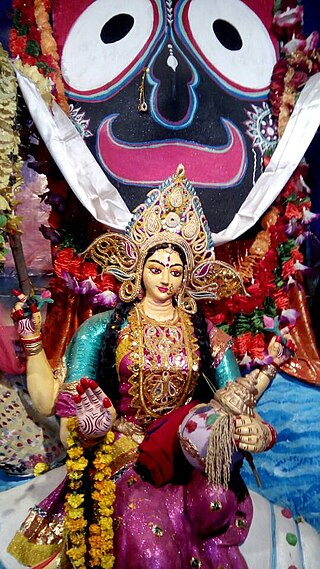
Lakshmi Puja is a Hindu occasion for the veneration of Lakshmi, the goddess of prosperity and the supreme goddess of Vaishnavism. The occasion is celebrated on the amavasya in the Vikram Samvat Hindu calendar month of Ashwayuja or Kartika, on the third day of Deepavali (Tihar) in most part of India and Nepal. In Assam, Bengal, and Odisha, this puja is celebrated five days after Vijaya Dashami.
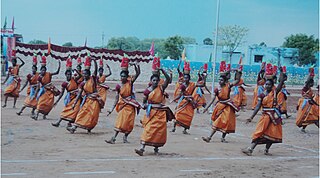
Karakattam, or Karagam Puja in the Caribbean, is an ancient folk dance of Tamil Nadu performed in praise of the rain goddess Mariamman. The ancient Tamil epic says that this type of dance derived from Bharatham and a mixture of multiple forms of Tamil dance forms like Bharatanatyam postures and mudras. The offering of this dance is to the goddess to bless rain. The dance accompanies songs like folk Carnatic (Amrithavarshini).

Gundicha Temple, is a Hindu temple, situated in the temple town of Puri in the state of Odisha, India. It is significant for being the destination of the celebrated annual Rath Yatra of Puri. While it remains vacant most of the year, the temple is occupied by images of the deities of Jagannath, his brother Balabhadra and sister Subhadra for seven complete days every year during the annual Rath Yatra festival.

Arulmigu Sri Bannari Mariamman Temple is an Amman temple in the Indian state of Tamil Nadu. It is located near Sathyamangalam, Erode district.
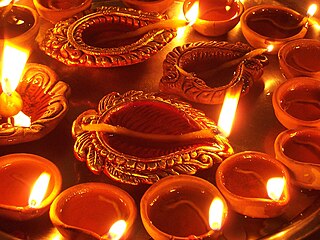
Worship in Hinduism is an act of religious devotion usually directed to one or more Hindu deities, invoking a sense of Bhakti or devotional love. This term is probably a central one in Hinduism, but a direct translation from the Sanskrit to English is difficult. Worship in Hinduism takes many forms, and its expression vary depending on geographical, linguistic, and cultural factors. Hindu worship is not limited to a particular place and Hindus perform worship in temples and within the home. It often incorporates personal reflection, music, dance, poetry, rituals, and ceremonies. Worship in Hinduism serves various purposes, including seeking blessings, guidance, or specific outcomes, as well as fostering a sense of inner peace and spiritual growth. It can also be an expression of devotion (bhakti) to the deity. The aim is to lead a pure life in order to progress spiritually and eventually attain liberation (moksha) from the cycle of rebirth.
The temple of Shree Balaji Mandir is located at Charkop, Kandivali (West). It is claimed to be the second home place of lord venkateshwara after Tirupati Temple.
Gangamma Jatara or Jathra is a folk festival celebrated in several places across Southern India; including Karnataka, Rayalaseema, Coastal Andhra and Uttarandhra regions in Andhra Pradesh. It is celebrated for eight days.
Venkateswara Temple is an important Vaishnavite temple situated in the hill town of Tirumala in Tirupati of Andhra Pradesh, India. The Temple is dedicated to Venkateswara, an incarnation of Vishnu, who is believed to be appeared here to save mankind from trials and troubles of Kali Yuga. The temple is situated at a height of 853 meters on Tirumala Hills which are part of Seshachalam Hills and is constructed in Dravidian Architectural Style.

Chikka Tirupati is a Hindu temple dedicated to Venkateshwara, the Hindu god Vishnu. It is located in Chikka Tirupathi Hobli of Malur Taluk, in the outskirts of Bengaluru in the South Indian state of Karnataka. Constructed in the Dravidian style of architecture, the temple is considered similar to the Tirupathi Venkateswara temple. Vishnu is worshipped as Venkateshwara and his consort Lakshmi as Alamelumangamma. Chikkathirupathy is 15 km (9.3 mi) from taluk headquarters Malur, 26 km (16 mi) from ITPL and 30 km (19 mi) from Koramangala.

Sri Gangamma Devi Temple is located near the Kadu Malleshwara temple on 2nd Temple Street, Malleshwara layout, in the north-western area of Bangalore city.
















